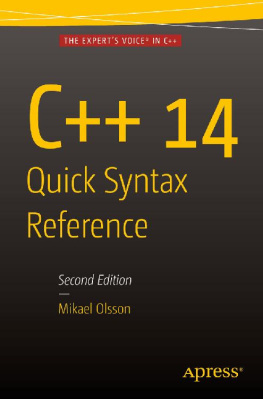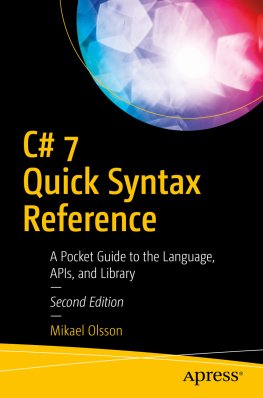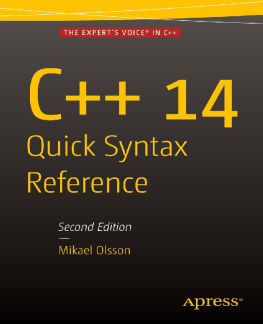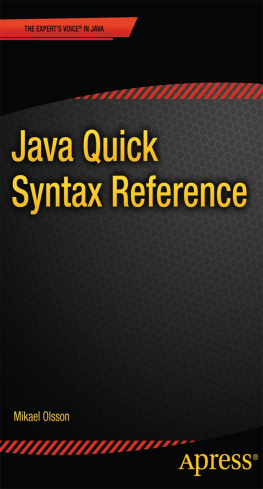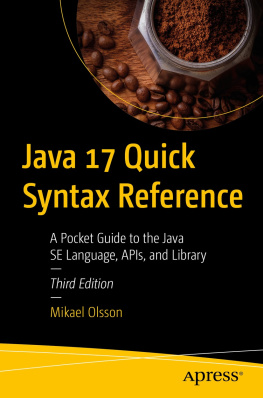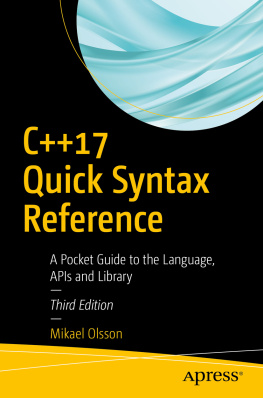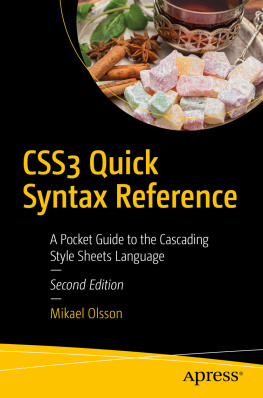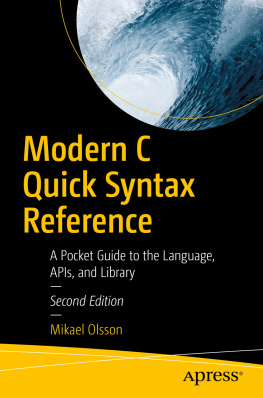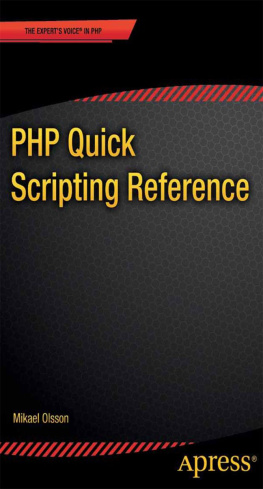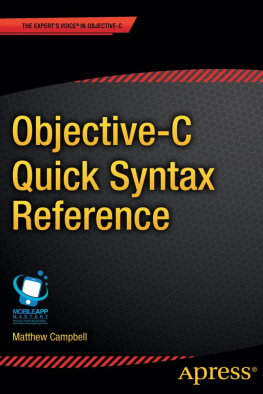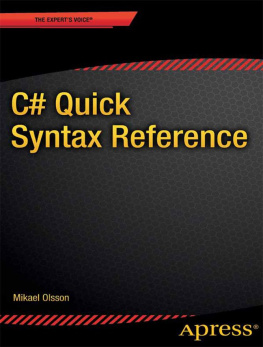Any source code or other supplementary material referenced by the author in this text is available to readers at www.apress.com/9781484217269 . For detailed information about how to locate your books source code, go to www.apress.com/source-code/ .
ISBN 978-1-4842-1726-9 e-ISBN 978-1-4842-1727-6
DOI 10.1007/978-1-4842-1727-6
Mikael Olsson 2015
C++ 14 Quick Syntax Reference
Managing Director: Welmoed Spahr
Lead Editor: Steve Anglin
Developmental Editor: Matthew Moodie
Editorial Board: Steve Anglin, Louise Corrigan, Jonathan Gennick, Robert Hutchinson, Michelle Lowman, James Markham, Susan McDermott, Matthew Moodie, Jeffrey Pepper, Douglas Pundick, Ben Renow-Clarke, Gwenan Spearing
Copy Editor: Karen Jameson
Coordinating Editor: Mark Powers
Compositor: SPi Global
Indexer: SPi Global
Artist: SPi Global
For information on translations, please e-mail rights@apress.com , or visit www.apress.com .
Apress and friends of ED books may be purchased in bulk for academic, corporate, or promotional use. eBook versions and licenses are also available for most titles. For more information, reference our Special Bulk SaleseBook Licensing web page at www.apress.com/bulk-sales .
This work is subject to copyright. All rights are reserved by the Publisher, whether the whole or part of the material is concerned, specifically the rights of translation, reprinting, reuse of illustrations, recitation, broadcasting, reproduction on microfilms or in any other physical way, and transmission or information storage and retrieval, electronic adaptation, computer software, or by similar or dissimilar methodology now known or hereafter developed. Exempted from this legal reservation are brief excerpts in connection with reviews or scholarly analysis or material supplied specifically for the purpose of being entered and executed on a computer system, for exclusive use by the purchaser of the work. Duplication of this publication or parts thereof is permitted only under the provisions of the Copyright Law of the Publishers location, in its current version, and permission for use must always be obtained from Springer. Permissions for use may be obtained through RightsLink at the Copyright Clearance Center. Violations are liable to prosecution under the respective Copyright Law.
Trademarked names, logos, and images may appear in this book. Rather than use a trademark symbol with every occurrence of a trademarked name, logo, or image we use the names, logos, and images only in an editorial fashion and to the benefit of the trademark owner, with no intention of infringement of the trademark. The use in this publication of trade names, trademarks, service marks, and similar terms, even if they are not identified as such, is not to be taken as an expression of opinion as to whether or not they are subject to proprietary rights.
While the advice and information in this book are believed to be true and accurate at the date of publication, neither the authors nor the editors nor the publisher can accept any legal responsibility for any errors or omissions that may be made. The publisher makes no warranty, express or implied, with respect to the material contained herein.
Distributed to the book trade worldwide by Springer Science+Business Media New York, 233 Spring Street, 6th Floor, New York, NY 10013. Phone 1-800-SPRINGER, fax (201) 348-4505, e-mail orders-ny@springer-sbm.com, or visit www.springeronline.com. Apress Media, LLC is a California LLC and the sole member (owner) is Springer Science + Business Media Finance Inc (SSBM Finance Inc). SSBM Finance Inc is a Delaware corporation.
Introduction
The C++ programming language is a general purpose multi-paradigm language created by Bjarne Stroustrup. Development of the language started in 1979 under the name C with classes. As the name implies, it was an extension of the C language with the additional concept of classes. Stroustrup wanted to create a better C that combined the power and efficiency of C with high-level abstractions to better manage large development projects. The resulting language was renamed to C++ (C-Plus-Plus) in 1983. As a deliberate design feature C++ maintains compatibility with C, and so most C code can easily be made to compile in C++.
The introduction of C++ became a major milestone in the software industry as a widely successful language for both system and application development. System programming involves software that controls the computer hardware directly, such as drivers, operating systems, and software for embedded microprocessors. These areas remain the core domain of the language, where resources are scarce and come at a premium. C++ is also widely used for writing applications, which run on top of system software, especially high-performance software such as games, databases, and resource-demanding desktop applications. Despite the introduction of many modern, high-level languages in this domain such as Java, C#, and Python C++ still holds its own and overall remains one of the most popular and influential programming languages in use today.
There are several reasons for the widespread adoption of C++. The foremost reason was the rare combination of both high-level and low-level abstractions from the hardware. The low-level efficiency was inherited from C, and the high-level constructs came in part from a simulation language called Simula. This combination makes it possible to write C++ software with the strength of both approaches. Another strong point of the language is that it does not impose a specific programming paradigm on its users. It is designed to give the programmer a lot of freedom by supporting many different programming styles or paradigms, such as procedural, object-oriented, and generic programming.
C++ is updated and maintained by the C++ standards committee. In 1998, the first international standard was published, known informally as C++98. The language has since undergone three more revisions with further extensions, including C++03; C++11; and most recently, C++14, which is the latest ISO standard for the C++ programming language released in 2014.
1. Hello World

